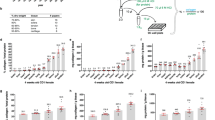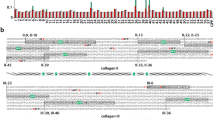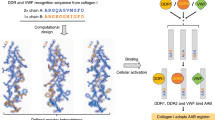Abstract
The collagens represent an interesting example of a structurally related but genetically distinct family of proteins1. Type I, the most abundant of the vertebrate collagens, comprises two proα1(I) chains and one proα2(I) chain, each containing terminal propeptides and a central domain of 338 (Gly, X, Y) repeats. The structure of the chicken proα2(I) gene shows an intriguing relationship between exon organization and the arrangement of (Gly, X, Y) repeats (see ref. 2 for review). This has led to the suggestion3 that the collagens evolved from a common ancestral unit of 54 base pairs (bp). Here we present the structure of the entire human proα1(I) gene and compare this with the chicken proα2(I). The exon arrangement of the two genes is remarkably similar, although the human proα1(I) is more compact because of the shorter length of its introns. The data strongly support the notion that the type I genes have evolved from an ancestral multi-exon unit, and that once the gene was translated, a strong evolutionary pressure caused it to maintain this elaborate structure.
This is a preview of subscription content, access via your institution
Access options
Subscribe to this journal
Receive 51 print issues and online access
$199.00 per year
only $3.90 per issue
Buy this article
- Purchase on Springer Link
- Instant access to full article PDF
Prices may be subject to local taxes which are calculated during checkout
Similar content being viewed by others
References
Bornstein, P. & Sage, H. A. Rev. Biochem. 49, 957–1003 (1980).
Tate, V., Finer, M., Boedtker, H. & Doty, P. Cold Spring Harb. Symp. quant. Biol. 47, 1039–1049 (1982).
Yamada, Y. et al. Cell 22, 887–892.
Sandell, L. et al. J. biol. Chem. 258, 11617–11621 (1982).
Yamada, Y. et al. J. biol. Chem. 258, 2758–2761 (1983).
Monson, J. M. et al. Molec. cell. Biol. 2, 1362–1371 (1982).
Fietzek, P. P. et al. Proc. natn. Acad. Sci. U.S.A. 74, 84–86 (1977).
Piez, K. A. in Biochemistry of Collagen (eds Ramachandran, G. N. & Reddi, A. H.) 1–84 (Plenum, New York, 1976).
Fietzek, P. P. & Kuhn, K. Int. Rev. Connective Tissue Res. 7, 1–60 (1976).
Tate, V. et al. Nucleic Acids Res. 11, 91–103 (1983).
Harbers, K. et al. Proc. natn. Acad. Sci. U.S.A. 81, 1504–1508 (1984).
Pesciotta, E. M. et al. Biochemistry 19, 2447–2454 (1980).
Yamada, Y. et al. J. biol. Chem. 258, 14914–14919 (1983).
Timpl, R. & Glanville, R. W. Clin. Orthop. Related Res. 158, 224–242 (1981).
Huerre, C. et al. Proc. natn. Acad. Sci. U.S.A. 79, 6627–6630 (1982).
Bernard, M. P. et al. Biochemistry 22, 5213–5223 (1983).
Ohta, T. & Dover, G. A. Proc. natn. Acad. Sci. U.S.A. 80, 4079–4083 (1983).
Myers, J. C. et al. J. biol. Chem. 258, 10128–10135 (1983).
Chu, M.-L. et al. Nucleic Acids Res. 10, 5424–5434 (1982).
Author information
Authors and Affiliations
Rights and permissions
About this article
Cite this article
Chu, ML., de Wet, W., Bernard, M. et al. Human proα1(I) collagen gene structure reveals evolutionary conservation of a pattern of introns and exons. Nature 310, 337–340 (1984). https://doi.org/10.1038/310337a0
Received:
Accepted:
Issue Date:
DOI: https://doi.org/10.1038/310337a0
This article is cited by
-
Single and multiplexed immunoassays for the chemiluminescent imaging detection of animal glues in historical paint cross-sections
Analytical and Bioanalytical Chemistry (2013)
-
Extracellular matrix formation by epithelial cells from human polycystic kidney cysts in culture
Virchows Archiv B Cell Pathology Including Molecular Pathology (1993)
-
Evolution of collagen IV genes from a 54-base pair exon: A role for introns in gene evolution
Journal of Molecular Evolution (1990)
Comments
By submitting a comment you agree to abide by our Terms and Community Guidelines. If you find something abusive or that does not comply with our terms or guidelines please flag it as inappropriate.



